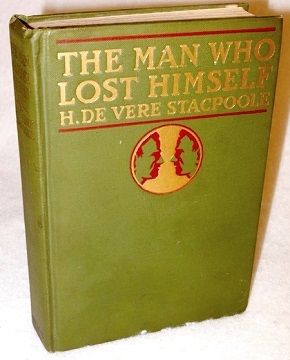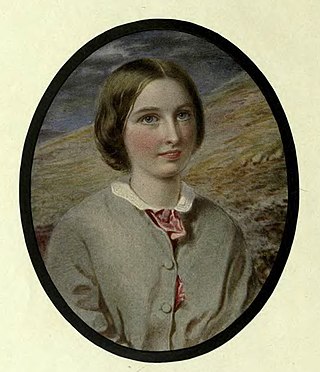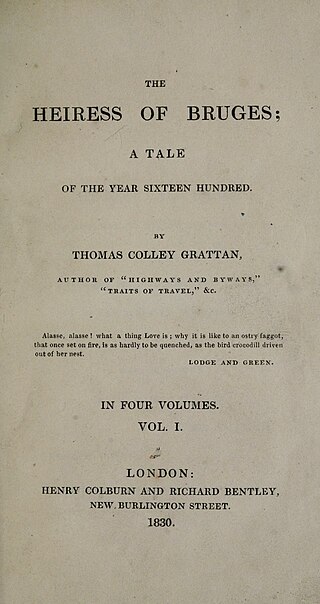
Katharine Tynan was an Irish writer, known mainly for her novels and poetry. After her marriage in 1893 to the Trinity College scholar, writer and barrister Henry Albert Hinkson (1865–1919) she usually wrote under the name Katharine Tynan Hinkson, or variations thereof. Tynan's younger sister Nora Tynan O'Mahony was also a poet and one of her three children, Pamela Hinkson (1900–1982), was also known as a writer. The Katharine Tynan Road in Belgard, Tallaght is named after her.
Thomas Colley Grattan was an Irish novelist, poet, historian and diplomat. Born in Dublin, he was educated for the law, but did not practise. He wrote a few novels, including The Heiress of Bruges ; but his best work was Highways and Byways, a description of his Continental travels, of which he published three series, amounting to eight volumes. He also wrote a history of the Netherlands and books on America. He was for some time British Consul at Boston in the United States and assisted in the negotiations leading to the Webster–Ashburton Treaty in 1842.

Karsten Alnæs is a Norwegian author, historian, and journalist, who has dual degrees in history and literature from the University of Oslo. He worked as a journalist and taught at the Norwegian School of Journalism. His bibliography includes 15 novels, 3 children’s books, a collection of novellas, and a number of non–fiction works.
Annie Hall Cudlip, writing as Mrs. Pender Cudlip, was an English novelist and writer. She edited Ours: A Holiday Quarterly and contributed regularly to All the Year Round, Frank Leslie's Popular Monthly, and other magazines in Britain and the United States between 1876 and 1884. Married to a theologian, Rev. Pender Hodge Cudlip, she was among the most prolific writers of romantic fiction: well over 100 novels and short stories between 1862 and the early 20th century. The best known include Theo Leigh (1865), A Passion in Tatters (1872), He Cometh Not, She Said (1873) and Allerton Towers (1882).
Pender Hodge Cudlip (1835–1911) was an English Anglican High Church clergyman, theologian and writer. Born in Cornwall, he became well known as a preacher in Devon and spent most of his clerical life there. As the husband of writer Annie Hall Cudlip, née Thomas, he self-published a series of books on religion and theology between 1895 and 1905.

The Lion of Flanders, or the Battle of the Golden Spurs is a major novel first published in 1838 by the Belgian writer Hendrik Conscience (1812–1883)—an early example of historical fiction. The book focuses on the medieval Franco-Flemish War and the Battle of the Golden Spurs of 1302 in particular. It is written in Conscience's typical stylistic romanticism and has been described as the "Flemish national epic".
Walter Jones was an Irish politician from County Leitrim. He held local offices in Leitrim and some minor national patronage offices, and entered Parliament on the interest of his relatives the Beresford family.
George Henry Jessop was an Irish playwright, librettist, journalist, and novelist. Born in Ireland and educated at Trinity College Dublin, Jessop began his career as a writer working for magazines in London before moving to California in 1873. There he worked as both a journalist and newspaper editor for five years before beginning a career as a playwright in the United States. His first play, A Gentleman from Nevada (1879), was a success and had a profitable run at Broadway's Fifth Avenue Theatre. This work was eclipsed by his third play, Sam'l of Posen; or, The Commercial Drummer (1881), which brought both fame and fortune to its star, the actor M. B. Curtis, who purchased the rights to the work outright from Jessop. It was notably the first play in the history of American theatre to present a positive portrayal of a Jewish character.
Frances Anne Edgeworth (1769–1865), known as Fanny, was an Irish botanical artist and memoirist. She was the stepmother and confidant of the author Maria Edgeworth.
Anne Fuller was an Irish novelist in the Gothic genre. She was one of the earliest women writers of Gothic fiction.
Mrs F. C. Patrick was an 18th-century writer of Gothic fiction with at least three novels to her name. She was one of the earliest female writers of Gothic fiction.
Marianne Kenley-Munster was an Irish Gothic writer, best known for her romance novel The Cottage of the Appenines, Or the Castle of Novina. A Romance (1806). She is thought to have been born in Ulster and to have died in Belfast.

The Man Who Lost Himself is a 1918 comedy drama novel by the Irish-born writer Henry De Vere Stacpoole. The plot revolves around an American from Philadelphia, Victor Jones, arriving in London to find himself the exact Doppelgänger of a British aristocrat.

Maria Catherine Price La Touche was an Irish writer.
Margracia Loudon was an Irish novelist and political author. She is known for her political works Philanthropic Economy (1835), The Light of Mental Science (1845), The Voices of Bulgaria (1846).
Mary Grace Susanna Crumpe, Comtesse de Milon de Villiers was an Irish novelist.

The Heiress of Bruges is an 1830 historical novel by the Irish writer Thomas Colley Grattan. It was released in four volumes by London publishers Henry Colburn and Richard Bentley. Grattan wrote the novel while living in Brussels, shortly before the Belgian Revolution led to its independence from Dutch rule. He dedicated to Lady Bagot, the wife of British Ambassador Sir Charles Bagot. The work is set in Bruges around 1600. He was inspired partly by the success of the Waverley novels, and one reviewer described novel as the work of a "Flemish Walter Scott". It was given a largely positive critical reception, sold fairly and well and was subsequently translated into several languages. Grattan followed it with another historical novel set in the Low Countries Jacqueline of Holland (1831).

Agnes de Mansfeldt is an 1836 historical novel by the Irish writer Thomas Colley Grattan, published in three volumes. It was his third novel, although he remained best known for his travelogues. Like the previous two it was strongly influenced by the Waverley novels of Walter Scott. It is set around the time of the Cologne War of the 1580s, provoked in part by the marriage of Agnes von Mansfeld-Eisleben to the Elector of Cologne and his conversation to Protestantism. In his preface, Grattan draws parallels between these historical events and the contemporary situation following the Belgian Revolution and the 1831 Treaty of London.
Harriet Frances Bagot, Lady Thynne, also known as Lady Charles Thynne, was a British novelist.
Sarah Dana Loring Greenough was an American novelist.







